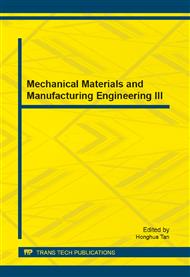[1]
J. Zh. Xu, X.C. Zhang,: THz technology science and application. The Series of Advanced Physics of Peking University, Peking University Press(2007): Beijing, pp.1-6. in Chinese.
Google Scholar
[2]
C.L. Zhang: Terahertz Sensing and Imaging, National Defense Industry Press: Beijing(2008), pp.218-220. in Chinese.
Google Scholar
[3]
W. Zh. Cui: Electromagnetics Metamaterials and its Application, National Defense Industry Press: Beijing(2008). in Chinese.
Google Scholar
[4]
H.T. Chen, W.J. Padilla, J.M.O. Zide, et al: Active terahertz metamaterial devices. Nature, Vol. 7119 (2006), pp.597-600.
DOI: 10.1038/nature05343
Google Scholar
[5]
T. Driscoll, S. Palit, M. M. Qazilbash, et al.: Dynamic tuning of an infrared hybrid-metamaterial resonance using vanadium dioxide, Applied Physics Letters. Vol. 2 (2008), p.24101.
DOI: 10.1063/1.2956675
Google Scholar
[6]
H.T. Chen, W.J. Padilla, M.J. Cich, et al.: A metamaterial solid-state terahertz phase modulator. Nature Photonics, Vol. 3 (2009), pp.148-151.
DOI: 10.1038/nphoton.2009.3
Google Scholar
[7]
W.J. Padilla, M.T. Aronsson, C. Highstrete, et al.: Electrically resonant terahertz metamaterials: Theoretical and experimental investigations. Physical Review B, Vol. 4(2007), p.041102.
DOI: 10.1103/physrevb.75.041102
Google Scholar
[8]
W.J. Padilla, A.J. Taylor, C. Highstrete, et al.: Dynamical Electric and Magnetic Metamaterial Response at Terahertz Frequencies. Physical Review Letters, Vol. 10(2006), p.107401.
DOI: 10.1103/physrevlett.96.107401
Google Scholar
[9]
Y. Yuan, C. Bingham, T. Tyler, et al.: Dual-band planar electric metamaterial in the terahertz regime. Optics Express, Vol. 13 (2008), pp.9746-9752.
DOI: 10.1364/oe.16.009746
Google Scholar
[10]
H.T. Chen, S. Palit, T. Tyler, et al.: Hybrid metamaterials enable fast electrical modulation of freely propagating terahertz waves. Applied Physics Letters, Vol. 9(2008), pp.091117-3.
DOI: 10.1063/1.2978071
Google Scholar
[11]
D. Seliuta, J. Macutkevič, R. Adomavičius, et al.: Modulation of monochromatic terahertz radiation in transmission and reflection modes using planar metamaterial. Electronics Letters, Vol. 8 (2011).
DOI: 10.1049/el.2011.0411
Google Scholar
[12]
Y. Yang, R. Huang L.Q. Cong, et al.: Modulating the fundamental inductive-capacitive resonance in asymmetric double-split ring terahertz metamaterials. Applied Physics Letters, Vol. 98 (2011), p.121114.
DOI: 10.1063/1.3571288
Google Scholar
[13]
O. Paul, C. Imhof, B. Lägel, et al.: Polarization-independent active metamaterial for high-frequency terahertz modulation. Optics Express, Vol. 2 (2009).
DOI: 10.1364/oe.17.000819
Google Scholar
[14]
A.K. Azad A.J. Taylor, E. Smirnova, et al.: Characterization and analysis of terahertz metamaterials based on rectangular split-ring resonators. Applied Physcis Letters, Vol. 1(2008), p.011119.
DOI: 10.1063/1.2829791
Google Scholar


